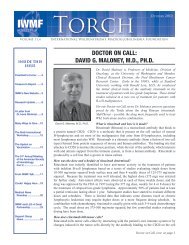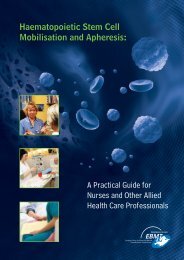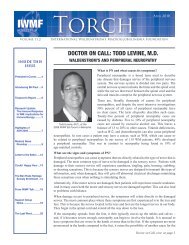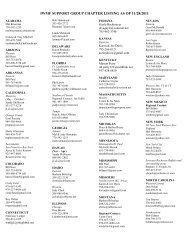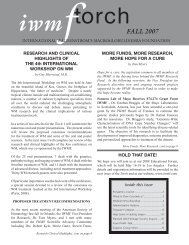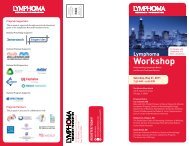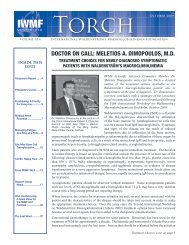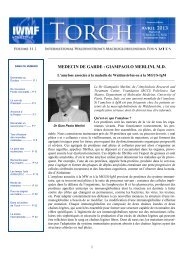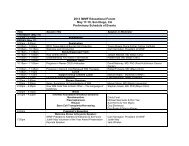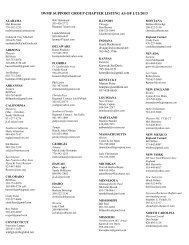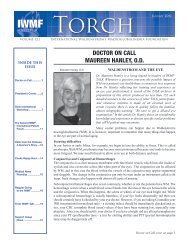English - International Waldenstrom's Macroglobulinemia Foundation
English - International Waldenstrom's Macroglobulinemia Foundation
English - International Waldenstrom's Macroglobulinemia Foundation
Create successful ePaper yourself
Turn your PDF publications into a flip-book with our unique Google optimized e-Paper software.
IWMF RESEARCH UPDATE<br />
b y Tom Myers, Vice President for Research<br />
New IWMF Grants Awarded<br />
The Waldenstrom’s <strong>Macroglobulinemia</strong> <strong>Foundation</strong> Canada<br />
(WMFC) and the Leukemia & Lymphoma Society (LLS)<br />
have agreed to jointly fund the proposal of Dr. Ruben<br />
Carrasco of the Dana-Farber Cancer Institute to develop a<br />
mouse model with the MYD88 L265P gene mutation. The<br />
IWMF will play a supporting role in providing technical<br />
oversight of the project. See below for reports on continuing<br />
research on the MYD88 mutation and on mouse modeling<br />
previously funded by the IWMF.<br />
In a new IWMF-supported research project, Dr. Kareem<br />
Azab at Washington University in St. Louis is studying “The<br />
Role of Hypoxia in the Dissemination of Waldenstrom’s<br />
<strong>Macroglobulinemia</strong>.” Hypoxia is a condition of low oxygen<br />
concentration. By exposing WM cells to low oxygen<br />
environments and then measuring their ability to move from<br />
one area to another, Dr. Azab has demonstrated that hypoxic<br />
conditions decrease the adhesion of WM cells to the bone<br />
marrow stroma (connective tissue) and increase their ability<br />
to migrate. He hypothesizes that hypoxia can thus cause WM<br />
cells to move to uninvolved areas in the bone marrow where<br />
oxygen is more plentiful. Dr. Azab will investigate the role of<br />
hypoxia in cell signaling and the identification of compounds<br />
affecting hypoxia.<br />
IWMF-Supported Research in Progress<br />
In 2011 the IWMF awarded a research grant to Dr. Steven<br />
Treon at the Dana-Farber Cancer Institute (DFCI) for a<br />
project entitled “Genomic Studies into Sporadic and Familial<br />
WM.” Using whole genome sequencing, Dr. Treon’s group<br />
demonstrated that over 90% of WM patients have a mutated<br />
gene designated MYD88 L265P. It was also determined that<br />
the mutated MYD88 gene was part of a signaling pathway<br />
containing several other components that affect the growth<br />
of WM cells. One of these components is designated as<br />
BTK (Bruton’s tyrosine kinase). Pharmacyclics and Janssen<br />
Biotech have developed an oral agent called ibrutinib that<br />
inhibits BTK. This agent appears very promising in recently<br />
announced preliminary studies treating WM, and as a result<br />
the FDA has granted Breakthrough Therapy Designation to<br />
ibrutinib in order to expedite the development and review<br />
time for this drug. At this time there is no FDA-approved<br />
drug for treating WM.<br />
Dr. Treon has submitted a grant request to the IWMF Research<br />
Committee to investigate the mechanisms whereby MYD88<br />
L265P is involved in causing or controlling WM. This project<br />
would also study various agents that could affect the manner<br />
in which MYD88 reacts with proteins that influence the<br />
growth and death of WM cells. The grant request is currently<br />
under review.<br />
With heightened research interest in MYD88, it becomes<br />
important to have cell lines and mouse models that exhibit<br />
this mutated gene.<br />
The WM cell line projects supported by the Leukemia &<br />
Lymphoma Society (LLS) and the IWMF have been very<br />
successful. Originally four researchers working independently<br />
attempted to develop cell lines. Dr. Stephen Ansell at Mayo<br />
Clinic and Dr. Asher Chanan-Kahn at Roswell Park (now at<br />
Mayo Clinic) have both produced lines that were judged to<br />
be useful in evaluating treatments for Waldenstrom’s since<br />
both cell lines exhibited the MYD88 L265P mutation. This<br />
is the third year of the cell line development project, and the<br />
IWMF is continuing support for Dr. Ansell and for Dr. Irene<br />
Ghobrial at DFCI. Dr. Ghobrial gave a preliminary report<br />
on her project to develop cell lines utilizing a mouse model<br />
at the IWMF 2012 Ed Forum. She has had success with<br />
growing mice that were injected with WM cells. In addition,<br />
Dr. Ghobrial reported the successful in vitro production of<br />
WM cells using growth compounds. A final report on her<br />
progress will be forthcoming this spring.<br />
The mouse model developed by Dr. Siegfried Janz at the<br />
University of Iowa, in a research project also supported by the<br />
IWMF, does not exhibit the mutated MYD88 gene. This model<br />
may be of value in WM research as some patients do not have<br />
the mutated gene. As noted above, the newly awarded grant to<br />
Dr. Ruben Carrasco, funded jointly by the IWMF, WMFC, and<br />
LLS, is for the development of a mouse model that exhibits the<br />
mutated MYD88 gene.<br />
The IWMF-funded project at Mayo Clinic led by Dr. Ansell<br />
shows continued progress in tracking down the proteins and<br />
transcription factors associated with the production of IgM in<br />
WM. In research completed under a previous IWMF grant,<br />
Dr. Ansell demonstrated that in WM patients the proteins<br />
BLyS and IL-6 were expressed in higher concentrations and<br />
that STAT5 was also over-expressed. His current research has<br />
studied the effect of STAT5 on the increases in BLyS and IL-6<br />
and shown that the use of agents minimizing the performance<br />
of STAT5 also reduce the secretion of IgM. Two forms of<br />
STAT5, labeled STAT5A and STAT5B, were identified.<br />
These two proteins are encoded by separate genes but are<br />
90% identical at the amino acid level. However, “knocking<br />
down” STAT5A in the serum appeared to be more effective<br />
in reducing IgM production than using STAT5B. This finding<br />
may open up new avenues in the treatment of WM.<br />
The tissue bank project that Dr. Ghobrial initiated in 2010<br />
is a major effort by IWMF to provide tissue samples and<br />
epidemiological data for researchers all over the world.<br />
The most recent report indicates that over 500 WM patients<br />
have prepared the epidemiological survey––with more than<br />
100 completing the survey at the 2012 IWMF Ed Forum.<br />
This information, in combination with blood, bone marrow<br />
samples, and buccal (cheek) cells, can be used to identify<br />
responses to therapy and the mechanisms of resistance. It is<br />
hoped that the causes of WM and the risks of developing the<br />
cancer will become clearer as a result of this project.<br />
Patient support of Dr. Ghobrial’s tissue bank project is vital.<br />
See the October 2012 issue of the Torch, pages 3 and 31, to<br />
learn how you can register. A representative from the tissue<br />
bank project will be available at the upcoming 2013 Ed Forum<br />
in San Diego to answer questions and sign up participants.<br />
IWMF TORCH Volume 14.2<br />
9



